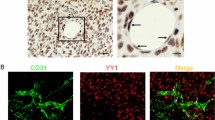Summary
Progressive tumor growth is dependent on angiogenesis. The mechanisms by which endothelial cells (ECs) are incorporated to develop new blood vessels are not well understood. Recent studies reveal that the ezrin radixin moesin (ERM) family members are key regulators of cellular activities such as adhesion, morphogenetic change, and migration. We hypothesized that ezrin, one of the ERM family members, may play important roles in ECs organization during angiogenesis, and new vessels formation in preexisting tissues. To test this hypothesis, in this study, we investigated the effects of ezrin gene silencing on the migration and angiogenesis of human umbilical vein endothelial cells (HUVECs) in vitro. HUVECs were transfected with plasmids with ezrin-targeting short hairpin RNA by using the lipofectamine-2000 system. Wound assay in vitro and three-dimensional culture were used to detect the migration and angiogenesis capacity of HUVECs. The morphological changes of transfected cells were observed by confocal and phase contrast microscopy. Our results demonstrated that the decreased expression of ezrin in HUVECs significantly induced the morphogenetic changes and cytoskeletal reorganization of the transfected cells, and also reduced cell migration and angiogenesis capacity in vitro, suggesting that ezrin play an important role in the process of HUVECs migration and angiogenesis.
Similar content being viewed by others
References
Sun Y, Huang J, Yang Z. The roles of ADAMTS in angiogenesis and cancer. Tumour Biol, 2015,28(6):1–13
Hanahan D, Folkman J. Patterns and emerging mechanisms of the angiogenic switch during tumorigenesis. Cell, 1996,86(3):353–364
Kusumanto YH, Dam WA, Hospers GA, et al. Platelets and granulocytes, in particular the neutrophils, form important compartments for circulating vascular endothelial growth factor. Angiogenesis, 2003,6(4):283–287
Orr FW, Wang HW, Lafrenie RM, et al. Interactions between cancer cells and the endothelium in metastasis. J Pathol, 2000,190(3):310–329
Davis GE, Mavila A, Bayless K. Molecular basis of endothelial cell morphogenesis in three-dimensional extracellular matrices. Anat Rec, 2002,268(3):252–275
Mentzer SJ, Konerding MA. Intussusceptive angiogenesis: expansion and remodeling of microvascular networks. Angiogenesis, 2014,17(3):499–509
Bonilha VL. Focus on molecules: Ezrin. Exp Eye Res, 2007,84(4):613–614
Daria B, Stefano F. The Janus-faced role of ezrin in “linking” cells to either normal or metastatic phenotype. Int J Cancer, 2009,125(10):2239–2245
Amanda LN, Richard GF. Ezrin, Radixin and Moesin: key regulators of membrane-cortex interactions and signaling. Current Opinion in Cell Biology, 2011,23(4): 377–382
Michael G, Joseph S. Molecular cloning: A laboratory Manual. 4th ed. American: Cold Spring Harbor Laboratory Press. 2013,28
Peng Y, Li J, Geng M. The glycan profile of endothelial cells in the present of tumor-conditioned medium and potential roles of beta-1,6-GlcNAc branching on HUVEC conformation. Mol Cell Biochem, 2010,340(1-2):143–152
Zhao LP, Xu G, Zhou JF, et al. The effect of RhoA on human umbilical vein endothelial cell migration and angiogenesis in vitro. Oncology Reports, 2006,15(5):1147–1152
Thomas K, Hellmut GA. Tensional forces in fibrillar extracellular matrices control directional capillary spouting. J Cell Sci, 1999,112(19):3249–3258
Park HJ, Kong D, Iruela-Arispe L, et al. 3-hydroxy-3-methylglutaryl coenzyme A reductase inhibitors interfere with angiogenesis by inhibiting the geranylgeranylation of RhoA. Circ Res, 2002,91(2):143–150
de Vega S, Suzuki N, Nonaka R. A C-terminal fragment of fibulin-7 interacts with endothelial cells and inhibits their tube formation in culture. Arch Biochem Biophys, 2014,545(10):148–153
Arnaoutova I, Kleinman HK. In vitro angiogenesis: endothelial cell tube formation on gelled basement membrane extract. Nat Protoc, 2010,5(4):628–635
Evellin S, Galvagni F, Zippo A. FOSL1 controls the aßsembly of endothelial cells into capillary tubes by direct repression of av and ß3 integrin transcription. Mol Cell Biol, 2013,33(6):1198–1209
Davis GE, Mavila A, Bayless K. Molecular basis of endothelial cell morphogenesis in three-dimensional extracellular matrices. Anat Rec, 2002,268(3):252–275
Drake CJ, Little CD. VEGF and vascular fusion: implications for normal and pathological vessels. J Histochem Cytochem, 1999,47(11):1351–1356
Niggli V, Rossy J. Ezrin/radixin/moesin: versatile controllers of signaling molecules and of the cortical cytoskeleton. Int J Biochem Cell Biol, 2008,40(3):344–349
Moleirinho S, Tilston-Lunel A, Angus L, et al. The expanding family of FERM proteins. Biochem J, 2013,452(2):183–193
Arpin M, Chirivino D, Naba A, et al. Emerging role for ERM proteins in cell adhesion and migration. Cell Adh Migr, 2011,5(2): 199–206
Fehon RG, McClatchey AI, Bretscher A. Organizing the cell cortex: the role of ERM proteins. Nat Rev Mol Cell Biol, 2010,11(4): 276–287
Bosanquet DC, Ye L, Harding KG, et al. FERM family proteins and their importance in cellular movements and wound healing. Int J Mol Med, 2014,34(1):3–12
Jiang QY, Xia JM, Ding HG, et al. RNAi-mediated blocking of ezrin reduces migration of ectopic endometrial cells in endometriosis. Mol Hum Reprod, 2012,18(9):435–441
Rasmussen M, Alexander RT, Darborg BV, et al. Osmotic cell shrinkage activates ezrin/radixin/moesin (ERM) proteins: activation mechanisms and physiological implications. Am J Physiol Cell Physiol, 2008,294(1):197–212
Hamada K, Shimizu T, Matsui T, et al. Structural basis of the membrane-targeting and unmasking mechanisms of the radixin ferm domain. EMBO J, 2000,19(17):4449–4462
Maniti O, Carvalho K, Picart C. Model membranes to shed light on the biochemical and physical properties of ezrin/radixin/moesin. Biochimie, 2013,95(1):3–11
Tsujita K, Itoh T. Phosphoinositides in the regulation of actin cortex and cell migration. Biochim Biophys Acta, 2015,1851(6):824–831
Gungor-Ordueri NE, Celik-Ozenci C, Cheng CY. Ezrin: a regulator of actin microfilaments in cell junctions of the rat testis. Asian J Androl, 2015,17(4):653–658
McClatchey AI. ERM proteins at a glance. J Cell Sci, 2014,127(15):3199–3204
Vásquez-Limeta A, Wagstaff KM, Ortega A, et al. Nuclear import of ß-dystroglycan is facilitated by ezrinmediated cytoskeleton reorganization. PLoS One, 2014,9(3):e90629
Author information
Authors and Affiliations
Corresponding author
Additional information
This project was supported by grants from the National Natural Science Foundation of China (No. 81101950) and Research Project Foundation of Health and Family Planning Commission of Wuhan City (No. WX15C37).
Rights and permissions
About this article
Cite this article
Zhao, Lp., Huang, L., Tian, X. et al. Knockdown of ezrin suppresses the migration and angiogenesis of human umbilical vein endothelial cells in vitro . J. Huazhong Univ. Sci. Technol. [Med. Sci.] 36, 243–248 (2016). https://doi.org/10.1007/s11596-016-1574-y
Received:
Revised:
Published:
Issue Date:
DOI: https://doi.org/10.1007/s11596-016-1574-y



